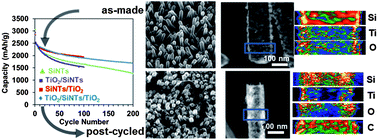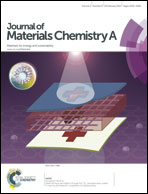Si nanotubes ALD coated with TiO2, TiN or Al2O3 as high performance lithium ion battery anodes†
Abstract
Silicon based hollow nanostructures are receiving significant scientific attention as potential high energy density anodes for lithium ion batteries. However their cycling performance still requires further improvement. Here we explore the use of atomic layer deposition (ALD) of TiO2, TiN and Al2O3 on the inner, the outer, or both surfaces of hollow Si nanotubes (SiNTs) for improving their cycling performance. We demonstrate that all three materials enhance the cycling performance, with optimum performance being achieved for SiNTs conformally coated on both sides with 1.5 nm of Li active TiO2. Substantial improvements are achieved in the cycling capacity retention (1700 mA h g−1vs. 1287 mA h g−1 for the uncoated baseline, after 200 cycles at 0.2 C), steady-state coulombic efficiency (∼100% vs. 97–98%), and high rate capability (capacity retention of 50% vs. 20%, going from 0.2 C to 5 C). TEM and other analytical techniques are employed to provide new insight into the lithiation cycling-induced failure mechanisms that turn out to be intimately linked to the microstructure and the location of these layers.

- This article is part of the themed collection: 2014 Journal of Materials Chemistry A Hot Articles

 Please wait while we load your content...
Please wait while we load your content...